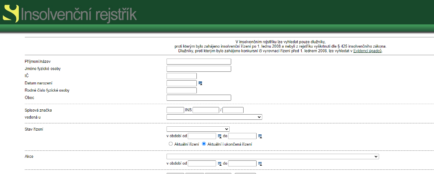File mark
Your submission, which you send or bring to the court in any form, will be given a file mark and a file will be created for it or it will become part of an existing file. The file mark is original for each file and is used to identify and locate the file. It may take various forms, but as a rule it consists of four parts.
The docket marking – if, for example, your neighbour owes you money, has no money to pay back and you sue them, your file will be marked C, for civil docket (which includes family law matters such as divorces and also custody cases). If, however, your neighbour stole money from you, you filed a criminal complaint against him and, after the usual steps, criminal charges were brought, the court file would be designated T, the criminal docket. These are the two most common and well-known designations among the public for the respective court registers under which the case file is kept.
In reality, however, many more such labels are used – for example, Tm for juvenile criminal matters, Ca for administrative docket, E for enforcement of court orders. You can recognize the file mark of an execution by EXE. It is easy to trace an execution by its file mark. Dozens of other designations are used. The individual designations also vary depending on whether the decision is a first- or second-instance decision, or what type of court is making the decision.
Tip for article
Tip: The system of courts in the Czech Republic may seem relatively clear and straightforward, but we still encounter a number of questions about it. This may be due to a somewhat confusing terminology or not clearly explained powers of some courts. Want to find a district court in Prague? Wondering which court is civil and which is criminal? We have set the record straight in our article.
The court department number – we find it before the register designation. However, it may happen that this number is missing because the court has only one register of the relevant type. In the case of ordinary courts, Arabic numerals are used for this designation, i.e. the number two in the case of the file number: 2 C 143/1999. In the case of the Constitutional Court, Roman numerals are used for this distinction, for example, the Roman four in the case of the file number IV. ÚS 579/22.
The serial number of the entry in the register for a given year – within an individual register, it is classical to start from one, and subsequent files that are filed there always bear a higher number. In the case of the aforementioned mark 2 C 143/1999, this is the one hundred and forty-fourth file.
The year in which the file is opened – In the above case, this would be 1999. However, it certainly does not mean that the file is closed in the same year.
Sometimes even seemingly different proceedings retain the same file mark for years. This happens in custody cases where, for example, custody and support for young children is settled in the context of a divorce, but a few years later, support needs to be increased. This is done under the same docket number. The same process also occurs when, in a few more years, the child decides as a teenager that he or she no longer wants to see one parent every week and the other parent applies for a change in alternate custody. All this takes place, for example, under a ten-year-old file marker.
Tip for article
Tip:The course of the criminal proceedings and its individual phases were discussed in a separate blog article.
Are you solving a similar problem?
Want to sue and not sure if you'll win?
We will assess your chances of success in court and propose a solution that will lead to the desired outcome. You will only succeed in court if your claim is bulletproof. We will conduct a careful analysis of your case and take care of preparing a pre-suit notice, a statement of claim, an appeal or straight to representing you in court where we will vigorously enforce your rights.
I want legal advice
- When you order, you know what you will get and how much it will cost.
- We handle everything online or in person at one of our 6 offices.
- We handle 8 out of 10 requests within 2 working days.
- We have specialists for every field of law.
Search by filename
The significance of the file mark is obvious: it is the identification of individual cases and therefore also of files. If you receive a summons from the court to make a statement on the opposing party’s submissions or to appear at an oral hearing, it must always be marked with a file mark. You can also use it to find your way around the court.
If you are interested in the course of court proceedings in which you are a party, just enter the file mark on the infosoud.justice.cz website. This is a very practical application in which you can see what steps have already taken place in a given proceeding (e.g. the opening of proceedings, the ordering of a hearing, the date of the final conclusion of the case, etc.). You can then obtain key facts about each step in a completely anonymised form, i.e. whether and when the step took place. The substance of the case is only referred to in very general terms (e.g. ‘action for payment of CZK 31 179.36 with accessories’ or ‘application for divorce’), but the parties themselves are not mentioned.
Tip for article
Hint: Searching by (among other things) filename is also possible at https://rozhodnuti.justice.cz/. Here you will find all judgments issued in an anonymised form. The database allows you to search based on a number of other parameters, such as the date of the decision, the court, the specific agenda (e.g. criminal, civil) or even the legal provision mentioned in the judgment. However, if you know the file number, you can access a specific judgment literally in a few clicks. We have discussed online search for court judgments in more detail in our article on the website.
Registration number
This term is sometimes confused with file number, mainly because it is not used uniformly by Czech authorities. In the case of an administrative office, the file number is essentially similar to a file mark, i.e. it denotes the file itself. In the case of court and court files, the file number is placed after the file mark and the hyphen and helps us to orientate ourselves in the file. For example, we can say that an expert report in the field of psychiatry has the file number 2 T 43/1999-22, so in this case the document is (begins) on the twenty-second sheet of the file. If the report is ten pages (or sheets) long, the next document in the file will have the number 2 T 43/1999-32.
Court file and filing service
Rules are written in the form of laws and regulations to ensure that the files are treated in the same way and go through the same processes. Generally, this system is called the filing service and is regulated by the Law on Archives and Filing Service.
In general, it can be electronic or in paper form in the form of various ‘shirts’ or ‘filing diaries’.
Tip for article
Hint: In this context, it is worth mentioning the project of electronic court files, which so far seems more like the music of the future than a reality. According to experts, the reality will sometimes be a hybrid case file, i.e. only partially computerised, as some documents cannot be converted into electronic form (for example, promissory notes).
In the case of some files, however, a move away from the documentary form would be more than desirable.
In the case of some files, however, a move away from the paper form would be more than desirable. Consider, for example, the now-historic court case of the Krakatica. The Krakatice dossier is the unofficial name of a dossier that suggested a connection between mafiosi, politicians and civil servants and ran to eleven thousand pages.
Summary
A court file is a document in which all information and actions related to a particular court case are recorded. Each case file has a unique file mark which is used to identify and locate it. This label usually includes the docket designation (e.g. C for civil, T for criminal), the court division number, the docket number in a given year, and the year the docket was created. Online systems are used to search for files and to track the progress of proceedings. In addition to the file marker, a file number is also used to identify individual documents within a file. Court files are managed according to the rules of the filing service, which determine their archiving and computerisation, with full computerisation of files still in the future.




